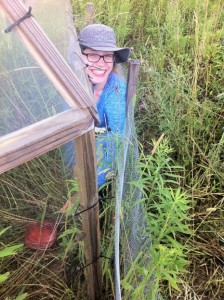My summer of science (fiction): reflections from an undergraduate researcher
Each summer Kellogg Biological Station Long-term Ecological Research supports students who participate in the Research Experiences for Undergraduates (REU) program, funded by the NSF.

Each summer Kellogg Biological Station Long-term Ecological Research supports students who participate in the Research Experiences for Undergraduates (REU) program, funded by the NSF. This is part of a larger undergraduate research program at KBS. Tori Niewohner is majoring in Environmental Science at Western Washington University. She wrote about her REU experience working with Kileigh Welshofer, a graduate student, and Dr. Phoebe Zarnetske.
After my first day at the field site I would be working at for the summer, I attempted to describe it to someone.
“Well, it’s a field of hexagonal structures surrounded by deer fence…” Before I completed the description, they responded: “Oh, you mean the things that look like something out of Star Wars?”
Looking at this first photo, the open-top chambers at the field site are reminiscent of science fiction.
When I decided to participate in a Research Experience for Undergraduates (REU) program at Kellogg Biological Station (KBS), I was unsure of what the summer held. But, sticking with the theme of science fiction, it was like walking through a Stargate.
For those who don’t know, a “Stargate” is a portal between worlds from the fictional Stargate universe. One of my favorite television shows is Stargate SG-1, which follows the military team SG-1 on their interplanetary adventures.
My time at KBS has been a bit like an episode of Stargate SG-1. Being from Washington state, Michigan is a whole new world. The sudden thunderstorms and lack of coniferous trees certainly made it feel like I was on a different planet!
In addition to the differing environment, I also witnessed a wide variety of what I considered to be alien-like insects and plants.
Who knew cicadas had such large and impressive eyes? And that Queen Anne’s Lace made such crazy looking seed stalks which bugs loved to hide in?
In addition to exploring other planets, the members of SG-1 often solve problems on those planets. Two of the characters are scientists, so the solutions are often scientifically based. During the summer, I had my fair share of scientific problem solving.
My project involved using the open top chamber warming and herbivory experiment at the KBS LTER. This experiment was in an old agricultural field and had 24 plots with a variety of warming and herbivory treatments achieved via passive open-top chambers, insecticide, and small mammal exclosure fences.
I investigated the effects of warming and herbivory on the flower abundance of several species. Initially, I wanted to look at the number of flowers produced per plant. However, due to the open-top chambers and fences, I could not get up close to distinguish between individual plants. So, I would have to count the total number of flowers in a plot. How could I account for the fact that certain plots might simply have a larger abundance of a certain species? Our team discovered the solution to look at relative flower abundance, that is, dividing the number of flowers by the percent cover of that species.
In addition to my research project, I also worked on taking photos of the plots in order to determine if someone could determine an accurate flower count from a photograph.
Initially, I attempted to take photographs with my phone on a selfie stick while standing on a step stool. Photo 4 is a great illustration of how that turned out. After taking a light fall (which is what this photo to the left captured), we decided this wasn’t the right method. Even though we haven’t quite figured out the solution, we are several steps closer to an answer.
New worlds and problem solving are great and all, but an episode of Stargate SG-1 wouldn’t be complete without some action. While my action didn’t involve battle scenes, it did involve army crawling!
My mentor and I went into the chambers to collect data at the beginning of the summer. The opening to the chambers is about a foot high, which means this requires crawling in amidst tall vegetation, all while paranoid that a tick might crawl under your clothing despite your socks over pants fashion statement. In addition, as the photo below illustrates, there’s not much room to maneuver!
At one point, I got into the chamber and we realized there was a wasp’s nest inside. In the name of science, I persevered and quickly gathered the data. Looking back, I wish I had said some witty one-liner about the situation like someone from Stargate SG-1 would have, but alas, I was not that quick on my feet.
All in all, this summer has been a phenomenal time and I have gained so much experience. If you are a scientist and ever tire of the trials and trepidations of science, just remember, you can count yourself in as an unofficial member of SG-1.




 Print
Print Email
Email



